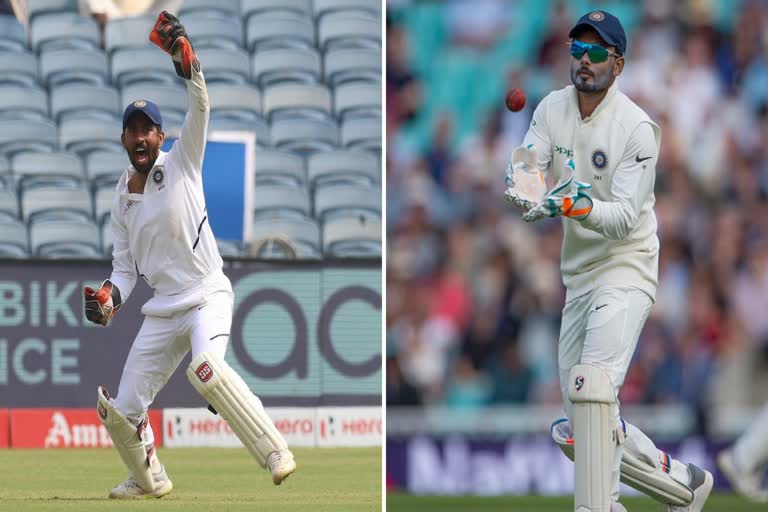Sydney: Rishabh Pant's contribution to the Sydney Test is two drop catches and 36 runs.
There is nothing new in this. His flip-flop performance as a specialist wicketkeeper-batsman has been at the heart of debate every time India play Test cricket.
In the ongoing Sydney Test, he dropped debutant Will Pucovski twice - once at 26 from a sharp reflex nick and once at 32 from a difficult chance over his head. Dropping Pucovski proved costly for India as the batsman went on to score 62. Had Pant held his catches, India would have finished with an edge over Australia in the first innings.
Australia would have not been able to post a 338 runs total. Since a half-fit, David Warner departed early India had chances to tighten their clutch over the hosts. But two lost chances meant Australia recovering from the early setback and posting a moderate total on board.
But there is no surprise in it because Pant's keeping technique has never been up to the standard of Test cricket. Whenever he was assigned to guard the stumps, there was hardly any occasion he didn't disappoint his team.
Rishabh Pant dropped Will Pucovski twice in Australia's first innings in Sydney. In a recent fielding metrics published by CricViz, Pant's record as a wicket-keeper since his debut in 2018 is the worst. He drops more catches than any other wicket-keeper.
The Indian gloveman also costs his team more runs than anyone else. In the Melbourne Test, he conceded 124 runs in an innings, but it was overlooked in the guise of an empathic victory.
Wridhiman Saha, who is regarded as a keeper with better technique, has always been preferred in the Indian conditions due to his superior glovework keeping against the spinners, while Pant gets priority when India play abroad due to his ability to add a value to the team as a batsman.
At the start of the 2020-21 Down Under tour, there was an exception when Saha was opted to play the Adelaide Day-Night Test considering his superior technique against the moving pink ball, but as soon as red ball returned Pant got the nod ahead of Saha.
Rishabh Pant suffered an elbow injury off Josh Hazlewood's delivery in the Sydney Test. India probably emphasised too much on his last tour's unbeaten 159 against Australia which came in a drawn Test at Sydney. But in the ongoing Test, when the team needed Pant to stay at the crease and show much more patience and resilience to adapt to the challenging conditions, he paved the way for the hosts giving away his wicket offering a catch to slip fielder Warner.
On the third-day morning session, India had lost the crucial wickets of captain Ajinkya Rahane and Hanuma Vihari, so a partnership was needed to rescue India from an impending collapse. But Pant, instead, opted to play his natural aggressive cricket and scored a breezy 36. A blow on his left elbow from a Pat Cummins delivery made him more vulnerable, and he eventually gave up the fight throwing away his wicket.
Following his dismissal, India couldn't resist more as the tourists' innings was wrapped up quickly. Pujara, India's only recognised batsman out at the crease, was dismissed in a span of an over by Pat Cummins.
Nevertheless, Pant's failure both as a wicket-keeper and batsman left India in a loop when the team needed him the most. They were eventually dismissed for 244, granting Australia a 94 runs lead.
The fact is that he is not a good wicket-keeper and if he fails to contribute with the bat that is the worst-case scenario India could ever imagine. Pant, in fact, is the only keeper to concede 124 runs in an innings. So, even if he manages to bat and score in the second innings, India's chances of making amendments to their squandered chances are slim as Australia got a solid edge in the game.
Wriddhiman Saha replaced injured wicket-keeper Rishabh Pant in the third Test at the Sydney Cricket Ground on Saturday. Saha can bat as we have seen him in T20 cricket, but he is no specialist in Test. However, he possesses better keeping skills than Pant.
In Test cricket, traditionally there are only a few wicket-keepers who made a buzz as a batsman, as well. Their keeping skills were as good as their batting's. But, this exclusive club has only a few members.
So, before the fourth and final Test of the Down Under tour, Indian team management needs to think seriously about what they want - a superior gloveman or batsman-keeper?
In Test cricket, keeping for long puts wicket-keepers in testing situations. Only those with better technique and agility succeed. And preserving the old art form of wicket-keeping is most important in the longer format than going for an exotic choice of keeper-batsman when you lack options.
--- By Sudipta Biswas
